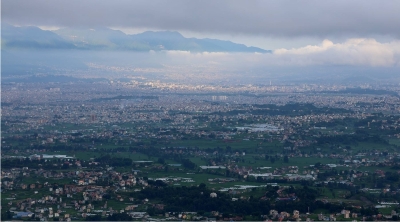NRA lacks fund to distribute second tranche of housing grant
Kathmandu, December 7
As the National Reconstruction Authority is preparing to distribute the second tranche of the government’s aid worth Rs 150,000 each to the beneficiary quake-survivor households, the authority sorely lacks funds this fiscal because the budget presented by the previous KP Sharma Oli-led government has allocated resources to distribute only Rs 80,000 as second instalment.
The incumbent government has decided to raise the grant amount for quake victims and is preparing to introduce a supplementary budget to bridge the resource gap to implement its announcement.
The ruling party, Communist Party of Nepal (Maoist-Centre), has been seeking consent from coalition partners and other political parties to bring the supplementary budget, according to Deputy Prime Minister and Finance Minister Krishna Bahadur Mahara.
Distribution of the second tranche will start from outside Kathmandu Valley as reconstruction of houses outside the Valley has gathered momentum along with the distribution of the first tranche. As per the Guideline on Grant Distribution for Reconstruction of Private Houses of NRA, the second tranche will be distributed after the foundation of the houses have been laid.
A total of 533,168 households, out of the 626,036 beneficiary households, have already signed the grant agreement with local bodies (village development committees and municipalities) in the 14 severely affected districts, including Kathmandu Valley, under the supervision of NRA.
The government requires Rs 79.98 billion to distribute the second tranche of grant amount, according to the Ministry of Finance (MoF).
Recently, the MoF authorised NRA to mobilise Rs 28 billion for the housing grant and has promised to release another Rs five billion within the next few days.
Simultaneously, NRA has to release first tranche of the grant to remaining 92,868 beneficiaries after they sign grant agreement with local bodies, which has been stalled due to lack of land ownership certificate, among other reasons.
On the other hand, the government is also preparing to distribute Rs 100,000 to people whose houses were damaged but would be fit to live in after maintenance in the quake-hit districts. Sushil Gyewali, CEO of NRA, said that the authority initially proposed to distribute Rs 50,000 for the maintenance of houses in quake-hit districts and the amount was later increased at the steering committee meeting led by the prime minister.
Furthermore, the government is also mulling over providing subsidised credit through banks for the reconstruction of houses with earthquake-resilient technology, according to Mahara. “For this, the government has to compensate the interest rate of the banks and financial institutions above the cut off rate.”
Apart from the housing grant, the government has to expedite reconstruction of schools, government buildings, heritage sites, earthquake ravaged roads, bridges and trekking trails, among others.
The budget this fiscal has allocated only Rs five billion for reconstruction of schools. However as per the estimation of the Post Disaster Recovery Framework (PRDF) — the five-year reconstruction plan of NRA — it is estimated that Rs 167 billion would be required for the reconstruction of schools equipped with basic facilities like libraries, drinking water, toilets, drainage and sanitation and playgrounds, among others within three years.
Mahara backed the need of a supplementary budget citing huge resource crunch to accelerate post-earthquake reconstruction. “The main motive of the formation of this government was to accelerate the slow reconstruction drive, which was witnessed in past.”
The fiscal budget of 2016-17 has allocated Rs 140 billion for reconstruction activities, but the amount has been classified under different headings and the funds allocated to one heading cannot be transferred to another.





